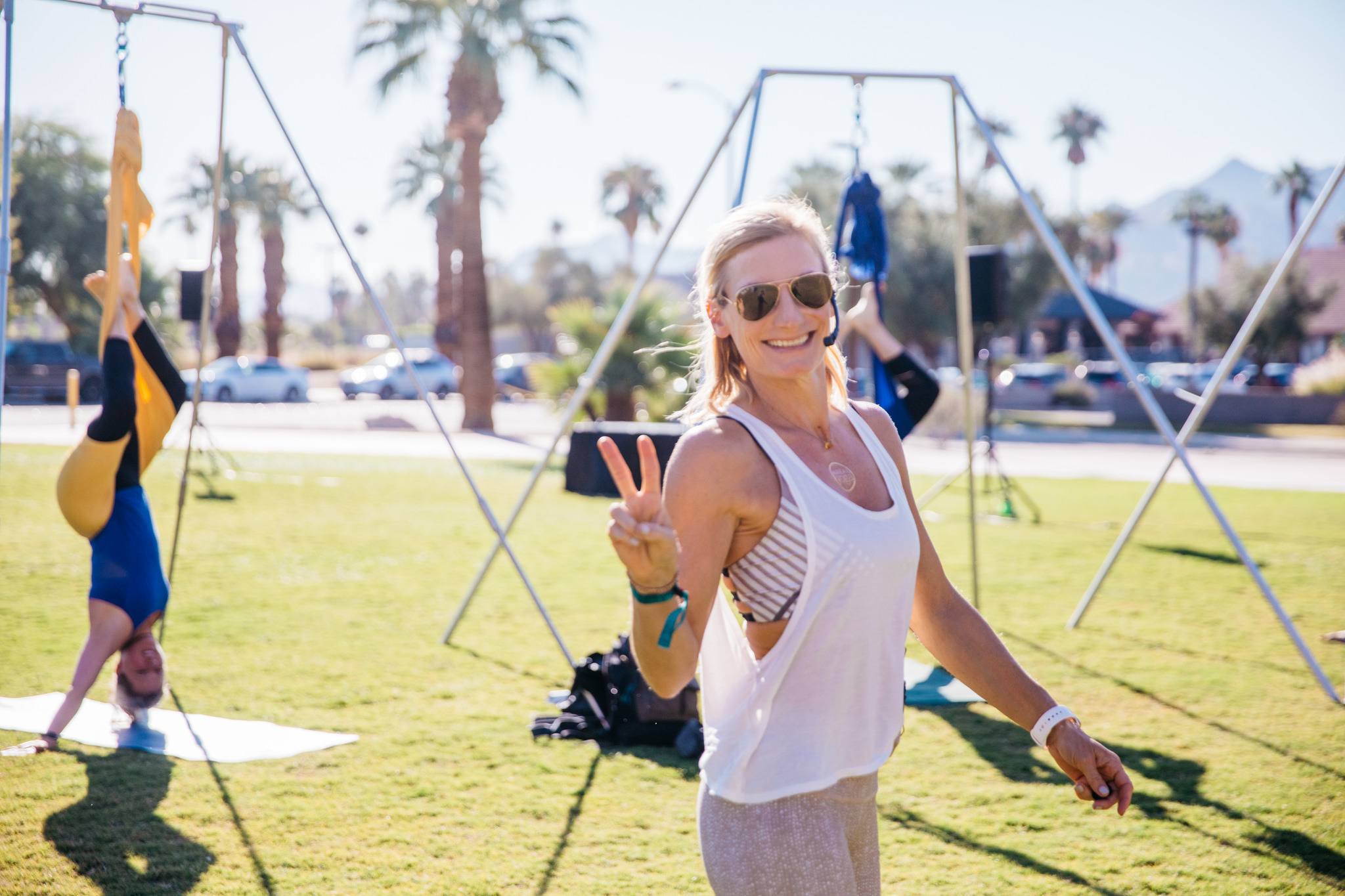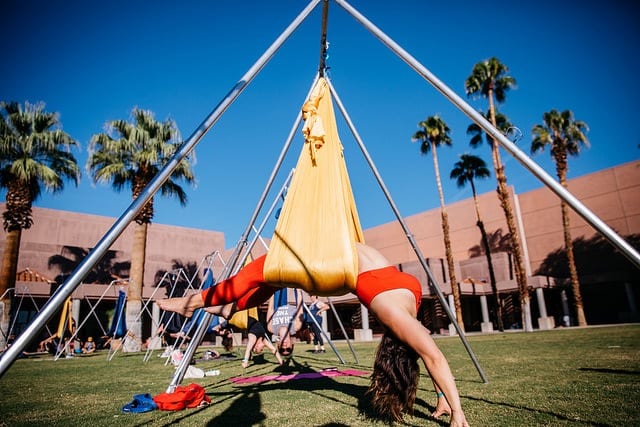
Yoga, while an incredible modality scientifically proven to improve both some physical conditions and emotional stress, can be dangerous. With the proliferation of 200-hour trainings that arguably leave certified teachers unequipped to address these very real dangers, this has become even more prominent.
Wanderlust teacher and founder of AIReal Yoga Carmen Curtis is one of the many teachers who have come to this conclusion, and is working to ensure that the practice remains a safe outlet for practitioners of all levels. “That means finding a good teacher,” says Carmen. “That means listening to your body. And it also means that props are probably going to be a necessity for most people,” she says.
According to Carmen, aerial yoga, and her proprietary AIReal Yoga™, is really all about the use of props. Aerial hammocks are a great way to introduce the use of props as necessity to practice, because, to be blunt, they’re less insulting to the ego. “People don’t think of it like a prop,” says Carmen. It’s a visually-appealing “cool” way to do yoga. But a hammock, she says, is doing the same thing as a strap or bolster. “It’s supporting you, and then it gives you space so you can do it safely or correctly,” says Carmen.
Take for example Warrior III, an intermediate balancing pose. Many practitioners, at all levels, compromise the integrity of the pose in an effort to hold their balance, compromising stabilization of the pelvis or hyperextending the standing leg. “Longterm, if you continue to do this, this is very dangerous for the body,” says Carmen. The pelvis is meant to be even—the hips squared—in this posture, but this is difficult to hold while lifting one leg.
“It’s not even always the ego,” says Carmen, “it’s just sometimes the posture is forcing us to cheat a little bit. If you hold the hammock, then you’re not worried so much about the balance, and you can put your body in the correct place. Your muscles can memorize it, learn to balance in that way.” When you then practice without the hammock, you can build into the shape more safely, she says.

Carmen’s Journey to Release the Ego
Master teachers like Carmen are not immune to the tropes of the ego. When she first started practicing in her late teens, she started with power yoga, then Kundalini, and into Hatha and Vinyasa. She remembers feeling as if she “wasn’t good enough” or “flexible enough” when given a block. “The ego set in like, ‘Damn right, I’m good enough! I’m just going to get myself there,’” she recalls.
Rather than working toward the posture safely, she’d compromise her body to achieve a picture-perfect version of the pose. In Dancer’s Pose, for example, she’d turn out her hip in order to get her foot up higher. “I wasn’t thinking that turning my hip out would actually lead to muscles memorizing that, and later having lower back pain, hip pain, and sciatica pain. It could also cause degeneration as its compressing the spine.”
This is why Carmen and other teachers are starting to change the way they communicate when teaching. “As a teacher trainer,” she says, “I’m trying to teach teachers to teach differently, to teach that the posture is done with a prop, that is good to use props, using a prop does not take away it enhances and makes the postures accessible and safe. The most important thing is to be in the safe correct alignment.”
I’m trying to teach teachers to teach differently. The most important thing is to be in the safe correct alignment.
This doesn’t mean, of course, that a student will always be using a prop in a particular posture. “As you progress, you can continue progress,” says Carmen, “but only if you stay in the safe, correct place. And the safe, correct place is what’s safe long term for your body. If you’re going to do this with repetition long term, then you need to have safe alignment.”
But an aerial rig, of course, isn’t the only prop to consider. “For so many postures,” says Carmen, “I would say I see like 75 percent of my clients can’t do it safely without a prop, like a block, blanket or strap.”
How We Got Here
The advent of social media, with its tendency to reward bikini-clad contortionists with thousands of likes and followers, has certainly played a role in exacerbating unsafe yoga practice. Yet neither Instagram nor the ego of individual yogis is 100 percent to blame for the reluctance to use—or the inability to teach with—props.
“When I started almost 25 years ago doing yoga, starting to take trainings, there weren’t props available to me in class,” says Carmen. “The industry wasn’t that big. It wasn’t like you could go online and find 25 different companies that sell bolsters.” So teachers, and students, did what they could with what they have. In this way, for many people, introducing props can feel like going backward—even if it is actually moving the practice forward.
B.K.S. Iyengar, who studied in Mysore with Krishnamacarya and wrote the seminal Light on Yoga, broke with his Ashtanga roots and introduced the use of props in the 1960s. “He knew that people needed props in order to do them safely and correctly,” says Carmen, “that every body is different, and that it doesn’t matter if you can do the posture or not—it really is about that journey and that process.”
Tips for Teachers
So what can we do to avoid unsafe practice? First, says Carmen, it’s important to approach yoga with the unobvious idea that being super flexible is actually a detriment. In order for the hyperflexible to do yoga safely, they need to pull out of poses—which is actually more work for their bodies than if they weren’t so bendy.
Another thing to look out for is hypermobility. “I’m going to have to cue [a hypermobile person] constantly, because their lazy state is when they hyperextend,” says Carmen. Unlike a less mobile person, whose bodies would warn them when they overexert, hyperextension won’t register as pain for they hypermobile. The other thing Carmen warns about is to watch for students who show signs that they need more strength around their ligaments. “You have to almost take this yoga practice as physical therapy for them to strengthen those ligaments,” she says.
It doesn’t matter if you can do the posture or not—it really is about that journey and that process.
For teachers, it’s about learning how to speak to your students to assuage the ego. It’s about “having empathy and compassion for each body and where they’re at, and then talking to the group so we can all understand that,” says Carmen. “That’s when people start to really realize it doesn’t matter where anyone else is.”
In this way, she says, yoga is the most selfish practice ever. “It’s all about you and what you need and your own self healing. And every posture that we do is all about you, and it’s a clue. It clues you into you and where you’re at and what you need. It has nothing to do with anyone else, just you. It’s your own clue. And the teacher is telling it to you and leading you through it and getting you in there so you can figure out what you need.”
Practice with Carmen this spring at Wanderlust O’ahu, and at Wanderlust Stratton, Squaw Valley, and Whistler. For tickets and more information, click here.
—
 Lisette Cheresson is currently the Director of Content at Wanderlust Festival. She’s a writer, storyteller, yoga teacher, and filmmaker who is an avid vagabond, dancer, dirt-collector, and dreamer. She received her Level II Reiki Attunement and attended a 4-day intensive discourse with the Dalai Lama in India, and received her RYT200 in Brooklyn. Catch her teaching @dayayogastudio, or find her on Instagram @lisetteileen.
Lisette Cheresson is currently the Director of Content at Wanderlust Festival. She’s a writer, storyteller, yoga teacher, and filmmaker who is an avid vagabond, dancer, dirt-collector, and dreamer. She received her Level II Reiki Attunement and attended a 4-day intensive discourse with the Dalai Lama in India, and received her RYT200 in Brooklyn. Catch her teaching @dayayogastudio, or find her on Instagram @lisetteileen.
